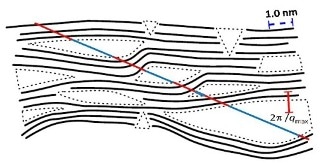Mar 14 2019
Nanostructures derived from carbon are very adaptable. They are capable of absorbing ions in batteries and supercapacitors, storing gases, and desalinating water. How well they handle the task at hand is contingent mostly on the structural characteristics of the nanopores. A new research from the HZB has, at present, demonstrated that structural variations that take place because of morphology transition with increasing temperature of the synthesis can also be measured straightaway—using small-angle X-ray scattering. The results have been reported in the journal Carbon.
 Schematic view of carbon structures with pores. (Copyright: HZB)
Schematic view of carbon structures with pores. (Copyright: HZB)
Enhanced nanoporous carbons can behave as electrodes for rapid electron and ion transport or increase the performance of energy storage and conversion devices. Therefore, the tunability of the shape, size, and distribution of pores is extremely required. Researchers at the HZB Institute for Soft Matter and Functional Materials worked together with a group at the University of Tartu, Estonia, to investigate the nanoarchitecture, size, inner surface, form, and distribution of nanopores in reliance of the synthesis settings.
From 600 to 1000 degrees
Contemporaries in Estonia fashioned a series of nanoporous carbons by reacting a powder of molybdenum carbide (Mo2C) with gaseous chlorine at 600, 700, 800, 900, and 1000 °C. Based on the synthesis conditions selected, the nanoporous carbon displays various properties such as surface area, hydrophilicity electronic and ionic conductivity, porosity, and electrocatalytic activity.
Small Angle X-Ray Scattering SAXS
Surface structures were examined using transmission electron microscopy at the HZB. The inner surface area of nanocarbon materials is typically examined by adsorption of gas. But, this technique is not only relatively inaccurate; it also has no information about the size and shape of the pores. For further understanding, Dr. Eneli Härk and her colleagues at HZB tested small-angle X-ray scattering, a method allowing information gathering on numerous structural features at the nanoscale including the mean pore size.
All About Nanopores
Small-angle X-ray scattering not only offers information on the exact inner surface area and the average pore size, but also on their angularity, i.e., sharp edges of formed pores, which have a key role to play for the functionalization of the materials.
The SAXS analysis summarizes over an enormous amount of micropores omitting misleading assumptions thereby directly relating the nanostructural architecture of the material to macroscopic technical parameters under investigation in engineering.
Dr. Eneli Härk, Researcher, HZB Institute for Soft Matter and Functional Materials.
The main goal was to comprehend structural formation and electrochemical features of carbon as a function of the synthesis temperature. “For optimal function, not only the high inner surface area is crucial, but the pores should have exactly the right shape, size and distribution”, says Härk.